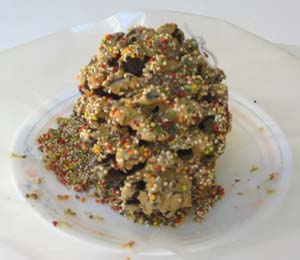Hello,
Our Kids Science Newsletter is published each month. The newsletter includes a question of the month, current science events, science trivia and a simple science activity that is fun for kids of all ages.
Question of the Month
What are jellyfish and where do they live?
(answer follows the simple science experiment)
Science Current Events
- Humpback Whales Thriving
- Humpback whales were hunted during the 19th and 20th Century using harpoons until there were only about 1,000 left in 1966. An international moratorium on whale hunting and other conservation efforts have tripled the number of whales migrating off the coasts of Brazil in the past ten years. There were 11,500 counted off the Brazil coast this year. Fishermen have been steering clear of whale breeding grounds where they were often caught in nets with their babies.
- Central America's Fuego (Fire) Volcano Erupts Again
- Fuego (Fire) volcano is one of Central America's most active volcanoes. It spewed lava and ash into the air for 28 hours. Last May and June the volcano sent pyroclastic flows of superheated debris down the volcano's slopes. Airplanes were rerouted around the ash plumes.
- Hippos Come to Visit
- Flooding rivers washed hippos, crocodiles and other dangerous animals into the villages along rivers in Nigeria. More than 10,000 people are living in streets and under bridges until the flood waters subside. Month long torrential rains have caused the flood waters to wash the dangerous animals into homes near the rivers. One man told BBC that a hippo was living in his home. He is hoping the hippo will get tired living there and leave his home.
- Rare Spiders Being Raised
- Test tubes are being used to raise baby spiders. The spiders are one of the largest and rarest spiders in Britain. Thousands of volunteers are trying to keep the spiders from becoming extinct. The great raft spider dolomedes plantarius is a giant water-gliding spider that lives in three wetland areas. The baby spiders are being raised and fed in test tubes to keep them from eating their siblings. Ten zoos across Britain are helping to save the spiderlings.
Science Trivia
- Snow flakes get smaller as the temperature drops because there is less and less moisture in the air. When the temperature drops below 10 degrees Fahrenheit it usually will not snow in an area.
- The reason that people often get motion sickness in a car is because your eyes are fixed to a book with your peripheral vision seeing the interior of the car. As the car goes over bumps, turns or changes its speed your ears disagree with what you are seeing and can often cause motion sickness.
- A frightened dog puts it's tail between it's legs because it covers the scent glands in the anal area. Since the anal glands carry personal scents that identify individual dogs. The tail between the legs behavior is the canine equivalent of insecure humans hiding their faces.
- Rainbows usually only last for a few minutes. But a rainbow seen in Wales on August 14, 1979 was said to have lasted for three hours.
Simple Science Activity
Pinecone Feeders

Introduction
During the winter birds will come to feeders to eat. In this activity you will be creating a feeder using an old pinecone that has opened to feed the birds.
Materials
- Pinecone
- Peanut butter (unsalted creamy peanut butter is best)
- Wild birdseed
- String, yarn or ribbon
- Plastic spoon or knife
- Plate
Directions
- Collect a pinecone in the woods or purchase one from a craft store.
- Plate the pinecone on a plate and smooth peanut butter ione the pinecone.
- Place wild birdseed on the plate and roll the pinecone in the seeds until they cover the peanut butter.
- Tie string to the pinecone that is about 18 inches long
- Tie the bird feeder to a limb or nail so it hangs where you can observe the birds while indoors.
- Enjoy watching the different birds that come to you feeder.
Science behind the experiment
Feeding birds is a fun activity for young and old. In some areas it is recommended that you use suet instead of peanut butter in these type of feeders so check with your local Audubon society.
Answer to the question of the month
What are jellyfish and where do they live?
Jellyfish are not really fish but a group of animals that float in water. The name jellyfish has been used for a group of animals that float in the ocean and look something like an umbrella. Most jellyfish are found floating on the surface of the ocean. Coronate jellyfish are deep-sea jelly fish with 12 thin tentacles that have adapted to the great pressures deep in the oceans. A deep-sea remote controlled underwater camera took a picture of a rarely studied jelly fish known as Deepstaria Enigmatica in October that lives 5,000 feet below the south Atlantic Ocean.
Please share the newsletter
Please share this newsletter with a friend by forwarding it to them. If you know of a group who might enjoy the newsletter please let them know about it also.
Comments? Ideas? Feedback? I'd love to hear from you. Just reply to this Just For Kids Science Newsletter and tell me what you think!
Sincerely yours,
Myrna Martin
Websites:
www.RingofFireScience.com
www.ScienceKitsForKids.com
www.Kids-Earth-Science.com
www.The-Science-Site.com

